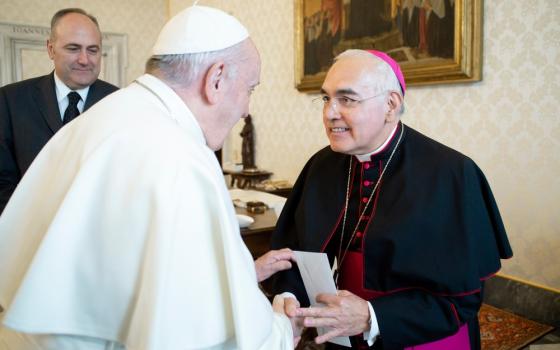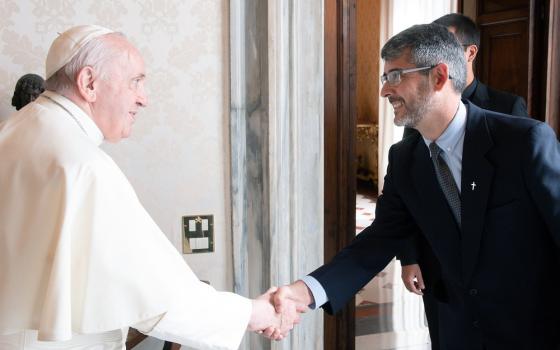I got a strange e-mail alert Oct. 11 that Pope Benedict XVI has apparently changed his original papal coat of arms. Most notably, he has replaced his original episcopal miter atop the shield or escutcheon with the more traditional papal tiara – a triple crown associated for centuries with the temporal as well as spiritual authority of the papacy.
The new coat of arms was unveiled Oct. 10 in a banner unfurled below the window of the papal study in the Apostolic Palace overlooking St. Peter’s Square, just before Benedict made his regular Sunday appearance there to speak and lead the noonday Angelus.

 Also notable in the new coat of arms was the disappearance of a chalice-shaped shield of other recent popes in favor of a more elaborate escutcheon that is surrounded in gold and bears no resemblance at all to a chalice.
Also notable in the new coat of arms was the disappearance of a chalice-shaped shield of other recent popes in favor of a more elaborate escutcheon that is surrounded in gold and bears no resemblance at all to a chalice.
A Benedict XVI innovation below the escutcheon at the time of his election – the papal pallium with three of its six crosses in red – has been replaced in the new version with a pallium showing four crosses – which if shown on its reverse as well would raise the traditional number of crosses on the pallium from six to eight.
Also, in the crossed gold and silver keys above the shield – recalling Christ’s promise to Peter that what he binds on earth shall be bound also in heaven – the traditional red cord with tassels linking the two keys (invisibly by an implied extension behind the shield) has been replaced by two distinct golden cords, one rising to the head of the golden key, the other rising to the head of the silver key.
As I looked at the new coat of arms it brought back vivid memories of Oct. 22, 1978, in St. Peter’s Square, when I heard Pope John Paul II, in his homily marking the inauguration of his Petrine ministry, declare:
“Pope John Paul I, whose memory is so vivid in our hearts, did not wish to have the tiara; nor does his successor wish it today. This is not the time to return to a ceremony and an object considered, wrongly, to be a symbol of the temporal power of the popes.”

 At the time, I thought two things:
At the time, I thought two things:
First, obviously John Paul II did not want to tie the hands of his successors, as to whether they would return to a papal coronation with a triple tiara instead of a more simple and pastoral solemn inauguration into their ministry as bishop of Rome and universal pastor.
Second, I detected a possible, perhaps even palpable, note of wistfulness: Did John Paul regret that because of the spirit of the times in 1978, he could not be crowned pope with the tiara that he described as “considered, wrongly, to be a symbol of the temporal power of the popes”? His use of “wrongly” certainly exhibited not just an opening to some future resumption of that tradition but a strong leaning toward it in some changed future atmosphere of public opinion.
When Benedict became the first pope in centuries to replace the triple crown above his heraldic papal shield with an episcopal miter, I thought that perhaps the final dagger had been thrust into the beast of papal claims of temporal power, symbolically completing Paul VI’s decision not to use the crown after his coronation and the decisions of John Paul I and II not to be crowned at all.
The new version of papal heraldry draws not only that but several other issues into question.
Why are the tassled cords to the two keys – representing Peter’s power to release from sins on earth and in heaven – no longer linked?
Why has the traditional chalice shape of the papal shield been abandoned?
Less significantly:
- Why have the original six peaks on the Moorish crown on the upper right (left from a viewer’s standpoint) of Benedict’s heraldic shield been changed to three?
- Why have the originally black stripes on the pack borne by the bear on the upper left (right from a viewer’s standpoint) been changed to white or silver?
- Why has the golden scallop shell on the main lower portion of the escutcheon been changed from a traditional realist image to a more artistic rendering?
To my knowledge, no recent pope before Benedict has changed the coat of arms he adopted at the start of his papacy.
The rationale for his changes rightfully deserves lively and critical discussion. What signals is the pope trying to send in the changes he has initiated?
Traditionally in heraldry, whether civic or ecclesiastical, my understanding has been that once a person adopts a set of heraldic symbols, he accepts them for life unless a new office calls for a review and possible change. For the pope to change the heraldry he adopted at the start of his papacy is, to my limited knowledge, probably without precedent.
[Jerry Filteau is NCR Washington correspondent.]



